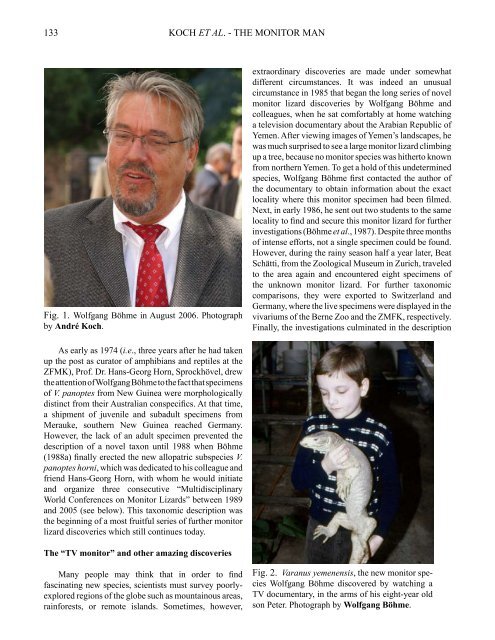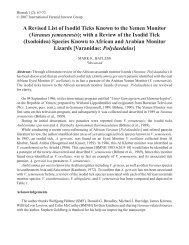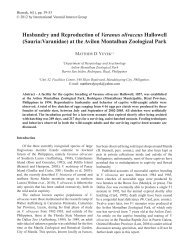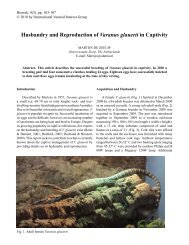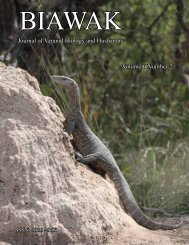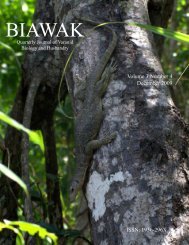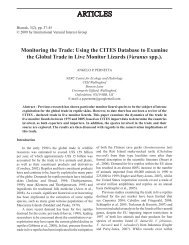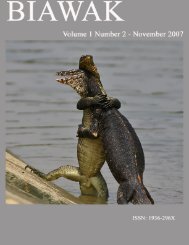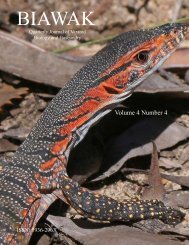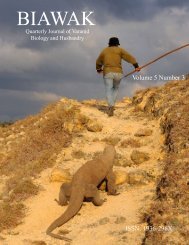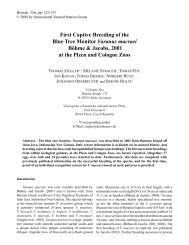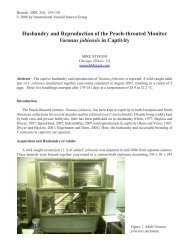BIAWAK - International Varanid Interest Group
BIAWAK - International Varanid Interest Group
BIAWAK - International Varanid Interest Group
- No tags were found...
You also want an ePaper? Increase the reach of your titles
YUMPU automatically turns print PDFs into web optimized ePapers that Google loves.
133<br />
KOCH ET AL. - THE MONITOR MAN<br />
Fig. 1. Wolfgang Böhme in August 2006. Photograph<br />
by André Koch.<br />
extraordinary discoveries are made under somewhat<br />
different circumstances. It was indeed an unusual<br />
circumstance in 1985 that began the long series of novel<br />
monitor lizard discoveries by Wolfgang Böhme and<br />
colleagues, when he sat comfortably at home watching<br />
a television documentary about the Arabian Republic of<br />
Yemen. After viewing images of Yemen’s landscapes, he<br />
was much surprised to see a large monitor lizard climbing<br />
up a tree, because no monitor species was hitherto known<br />
from northern Yemen. To get a hold of this undetermined<br />
species, Wolfgang Böhme first contacted the author of<br />
the documentary to obtain information about the exact<br />
locality where this monitor specimen had been filmed.<br />
Next, in early 1986, he sent out two students to the same<br />
locality to find and secure this monitor lizard for further<br />
investigations (Böhme et al., 1987). Despite three months<br />
of intense efforts, not a single specimen could be found.<br />
However, during the rainy season half a year later, Beat<br />
Schätti, from the Zoological Museum in Zurich, traveled<br />
to the area again and encountered eight specimens of<br />
the unknown monitor lizard. For further taxonomic<br />
comparisons, they were exported to Switzerland and<br />
Germany, where the live specimens were displayed in the<br />
vivariums of the Berne Zoo and the ZMFK, respectively.<br />
Finally, the investigations culminated in the description<br />
As early as 1974 (i.e., three years after he had taken<br />
up the post as curator of amphibians and reptiles at the<br />
ZFMK), Prof. Dr. Hans-Georg Horn, Sprockhövel, drew<br />
the attention of Wolfgang Böhme to the fact that specimens<br />
of V. panoptes from New Guinea were morphologically<br />
distinct from their Australian conspecifics. At that time,<br />
a shipment of juvenile and subadult specimens from<br />
Merauke, southern New Guinea reached Germany.<br />
However, the lack of an adult specimen prevented the<br />
description of a novel taxon until 1988 when Böhme<br />
(1988a) finally erected the new allopatric subspecies V.<br />
panoptes horni, which was dedicated to his colleague and<br />
friend Hans-Georg Horn, with whom he would initiate<br />
and organize three consecutive “Multidisciplinary<br />
World Conferences on Monitor Lizards” between 1989<br />
and 2005 (see below). This taxonomic description was<br />
the beginning of a most fruitful series of further monitor<br />
lizard discoveries which still continues today.<br />
The “TV monitor” and other amazing discoveries<br />
Many people may think that in order to find<br />
fascinating new species, scientists must survey poorlyexplored<br />
regions of the globe such as mountainous areas,<br />
rainforests, or remote islands. Sometimes, however,<br />
Fig. 2. Varanus yemenensis, the new monitor species<br />
Wolfgang Böhme discovered by watching a<br />
TV documentary, in the arms of his eight-year old<br />
son Peter. Photograph by Wolfgang Böhme.


